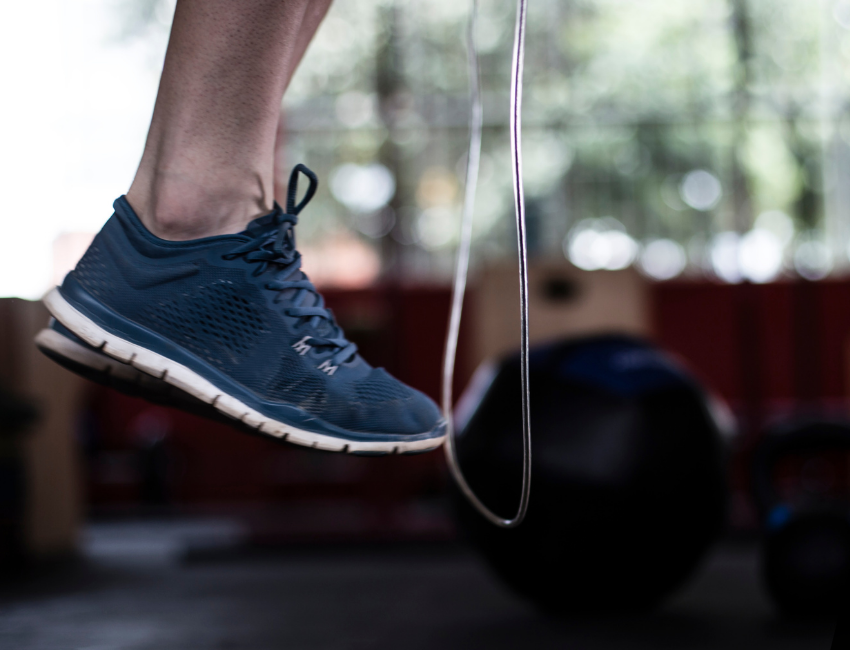The good ole’ jump rope, one of the most tried and true pieces of fitness equipment ever. From your average joe to a world champion boxer, jumping rope is a popular exercise that is firmly planted as one of the most versatile activities people choose to partake in. It can be used to get in shape, teach coordination to kids, or even compete within; but can jumping rope be used to increase your vertical jump?
Yes, jumping rope will increase a person’s vertical jump. It conditions the foot and ankle complex through the repetitive jumps, which results in an improved ability to produce and absorb force. Ultimately resulting in a higher max jump height and a reduced risk of lower leg injuries.
Now, how you successfully accomplish this requires a bit of detail and an approach not commonly utilized with a jump rope.
How To Use A Jump Rope To Increase Your Vertical Jump?
So, while it is possible to increase your vertical jump by simply deciding to jump rope, how exactly you go about achieving that requires a specific approach to training. The vertical jump is an explosive exercise, commonly utilized to assess an athletes ability to generate vertical force. It is one of the main metrics used to understand an athlete’s individual profile. This is universal across nearly each and every sport.
If you need a reminder of this just look to the upcoming NFL combine, outside of the 40 yard dash and the bench press, no other performance test will be talked about more than the vertical jump. This is true across the board, all field and court based sports use this exercise within their combine evaluations and within their weekly training programs.
You will notice that by now I have not mentioned a single thing about conditioning or cardio, that is because the ability to jump high off the ground is comprised of a short explosive action, and not one that is meant to be done repeatedly. Yet still, the main way people use a jump rope is as a means of “getting in shape” or burning fat. I recommend that you ignore the plethora of articles out there touting multiple 3 to 5 minute sets of jump rope as the miracle solution to all of your fitness and performance needs. Instead, begin to view jumping rope for what it really is, a type of exercise with an infinite number of variables, all of which will result in a different desired outcome depending on how it is utilized.
How Long You Jump For Matters
As I started to elude to above, the way with which you use the jump rope itself is what determines the result of your efforts. If you jump for multiple consecutive minutes and repeat that for at least a few sets, that would result in a great cardiovascular effect, which then means a good amount of calories burned. Now remember the vertical jump is an explosive power based exercise, so if you are trying to increase your total jump height the activities you perform need to be shorter duration and higher intensity by nature.
This means that if you want to use a jump rope to increase your vertical jump you need to be focusing on short bouts of exercise that are less than 90 seconds, followed by a rest period of at least 60 seconds.
Within those shorter duration guidelines we are still using the jump rope as a way of conditioning, just more so in a targeted and localized sense. We are implementing this jump rope strategy to improve the capacity of the muscles and tendons, specifically those found in the lower leg (foot, ankle, calf).
These lower intensity jumps serve to prepare the body to withstand the higher forces that are exerted during jump training and plyometrics exercises. Jumping rope in this way will still target the vertical jump, but at a lower intensity that doesn’t significantly contribute towards fatigue, while also allowing us to still improve within the overall context of the movement.
Jumping Rope Is Not The Only Solution
For most people, jumping rope will only help increase their vertical jump a small amount. This is because it covers a small fraction of what goes into being an explosive jumper. In fact, if you can attribute a significant improvement in jump height from simply just skipping some rope you were probably significantly de-trained to begin with. The intensity is just not there, and to be explosive you have to train explosive.
Now it can still be a useful tool in the process, just not the end all be all. There are other exercises that you need to be doing on a consistent basis to get the most out of your vertical.
For starters you need to be jumping maximally multiple times per week. That is really all a vertical jump is, and to get good at anything you need to repeatedly practice it. By jumping maximally you will engage the nervous system in a way that is not present during a bout of jump rope. This is key in developing the ability to rapidly generate force. You can train max jumps in a multitude of ways and I’d recommend exposing your body to the entire spectrum of appropriate reps and variations.
After jumping itself, I would say strength training is a key component of being able to jump higher and it needs to be present within your program. Strength itself is foundational for movement and in the case of explosive movements it is a pre-requisite before even attempting the task. Total body strength is important here but there should be an emphasis on lower body lifts within a vertical jump program. The exact type of lifts will depend on an athlete’s chronological and training ages, as well as the equipment available.
Increase Your Vertical By Jumping Rope . The Evidence.
There are a few studies that substantiate the claim that jumping rope can increase your vertical jump height. A 1991 study of middle school females showed that a 9 week depth jump protocol and a 9 week jump rope protocol resulted in nearly identical improvements in vertical height. It is important to note that in this study the participants did not jump rope in the traditional cardio focused way. Instead, they jumped with maximal effort for three 30 second intervals, with one minute rest between each set. This was performed only twice per week throughout the course of the research period.
Another study on 12 national-level track and field athletes looked at the results of a jump rope warm-up on peak power and jumping ability. Three warm-up protocols were used, the first utilized traditional jumps, the second was rope jumps, and the control was a general warm-up of jogging and stretching. The jump rope protocol significantly improved jumping distance when compared to the traditional jump. Everything else was comparable between the two and overall this study showed that jumping rope was just as effective as other protocols for athletes.
So, Does Jumping Rope Increase Your Vertical?
At this point now I think it is safe to say that jumping rope will improve your vertical jump. Like most things within the fitness industry it ultimately comes down to how you use it. If performed at the right intensity and duration, jumping rope will definitely condition the foot and ankle complex, which is pivotal in jumping ability. Just remember that you have to do more than jump a little rope to maximize your vertical.
Things like lifting weights, plyometrics, and sprinting need to be a part of your program for a well-rounded training approach. For more details on what a well-rounded approach to increasing your vertical jump looks like, check out our recent article on daily jump training.

